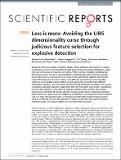| dc.contributor.author | Kumar Myakalwar, Ashwin | |
| dc.contributor.author | Spegazzini, Nicolas | |
| dc.contributor.author | Zhang, Chi | |
| dc.contributor.author | Kumar Anubham, Siva | |
| dc.contributor.author | Dasari, Ramachandra R. | |
| dc.contributor.author | Barman, Ishan | |
| dc.contributor.author | Kumar Gundawar, Manoj | |
| dc.contributor.author | Dasari, Ramachandra Rao | |
| dc.date.accessioned | 2015-12-28T16:03:16Z | |
| dc.date.available | 2015-12-28T16:03:16Z | |
| dc.date.issued | 2015-08 | |
| dc.date.submitted | 2015-01 | |
| dc.identifier.issn | 2045-2322 | |
| dc.identifier.uri | http://hdl.handle.net/1721.1/100537 | |
| dc.description.abstract | Despite its intrinsic advantages, translation of laser induced breakdown spectroscopy for material identification has been often impeded by the lack of robustness of developed classification models, often due to the presence of spurious correlations. While a number of classifiers exhibiting high discriminatory power have been reported, efforts in establishing the subset of relevant spectral features that enable a fundamental interpretation of the segmentation capability and avoid the ‘curse of dimensionality’ have been lacking. Using LIBS data acquired from a set of secondary explosives, we investigate judicious feature selection approaches and architect two different chemometrics classifiers –based on feature selection through prerequisite knowledge of the sample composition and genetic algorithm, respectively. While the full spectral input results in classification rate of ca.92%, selection of only carbon to hydrogen spectral window results in near identical performance. Importantly, the genetic algorithm-derived classifier shows a statistically significant improvement to ca. 94% accuracy for prospective classification, even though the number of features used is an order of magnitude smaller. Our findings demonstrate the impact of rigorous feature selection in LIBS and also hint at the feasibility of using a discrete filter based detector thereby enabling a cheaper and compact system more amenable to field operations. | en_US |
| dc.description.sponsorship | National Institute for Biomedical Imaging and Bioengineering (U.S.) (9P41EB015871-27A1) | en_US |
| dc.language.iso | en_US | |
| dc.publisher | Nature Publishing Group | en_US |
| dc.relation.isversionof | http://dx.doi.org/10.1038/srep13169 | en_US |
| dc.rights | Creative Commons Attribution | en_US |
| dc.rights.uri | http://creativecommons.org/licenses/by/4.0/ | en_US |
| dc.source | Nature Publishing Group | en_US |
| dc.title | Less is more: Avoiding the LIBS dimensionality curse through judicious feature selection for explosive detection | en_US |
| dc.type | Article | en_US |
| dc.identifier.citation | Kumar Myakalwar, Ashwin, Nicolas Spegazzini, Chi Zhang, Siva Kumar Anubham, Ramachandra R. Dasari, Ishan Barman, and Manoj Kumar Gundawar. “Less Is More: Avoiding the LIBS Dimensionality Curse through Judicious Feature Selection for Explosive Detection.” Scientific Reports 5 (August 19, 2015): 13169. | en_US |
| dc.contributor.department | Massachusetts Institute of Technology. Department of Chemistry | en_US |
| dc.contributor.department | Massachusetts Institute of Technology. Laser Biomedical Research Center | en_US |
| dc.contributor.department | Massachusetts Institute of Technology. Spectroscopy Laboratory | en_US |
| dc.contributor.mitauthor | Spegazzini, Nicolas | en_US |
| dc.contributor.mitauthor | Dasari, Ramachandra Rao | en_US |
| dc.relation.journal | Scientific Reports | en_US |
| dc.eprint.version | Final published version | en_US |
| dc.type.uri | http://purl.org/eprint/type/JournalArticle | en_US |
| eprint.status | http://purl.org/eprint/status/PeerReviewed | en_US |
| dspace.orderedauthors | Kumar Myakalwar, Ashwin; Spegazzini, Nicolas; Zhang, Chi; Kumar Anubham, Siva; Dasari, Ramachandra R.; Barman, Ishan; Kumar Gundawar, Manoj | en_US |
| dc.identifier.orcid | https://orcid.org/0000-0003-1190-3144 | |
| mit.license | PUBLISHER_CC | en_US |
| mit.metadata.status | Complete | |
